Catharism was a Christian dualist or Gnostic movement between the 12th and 14th centuries which thrived in Southern Europe, particularly in northern Italy and southern France. Followers were described as Cathars and referred to themselves as Good Christians, and are now mainly remembered for a prolonged period of religious persecution by the Catholic Church, which did not recognize their unorthodox Christianity. Catharism arrived in Western Europe in the Languedoc region of France in the 11th century. The adherents were sometimes referred to as Albigensians, after the city Albi in southern France where the movement first took hold. The belief may have originated in the Byzantine Empire. Catharism was initially taught by ascetic leaders who set few guidelines and so some Catharist practices and beliefs varied by region and over time. The Catholic Church denounced its practices, including the consolamentum ritual by which Cathar individuals were baptised and raised to the status of "Perfect".

The Albigensian Crusade or the Cathar Crusade was a 20-year military campaign initiated by Pope Innocent III to eliminate Catharism in Languedoc, in southern France. The Crusade was prosecuted primarily by the French crown and promptly took on a political aspect, resulting in not only a significant reduction in the number of practising Cathars, but also a realignment of the County of Toulouse in Languedoc, bringing it into the sphere of the French crown, and diminishing both Languedoc's distinct regional culture and the influence of the counts of Barcelona.

The Château de Montségur is a former fortress near Montségur, a commune in the Ariège department in southern France. Its ruins are the site of a razed stronghold of the Cathars. The present fortress on the site, though described as one of the "Cathar castles," is actually of a later period. It has been listed as a monument historique by the French Ministry of Culture since 1862.
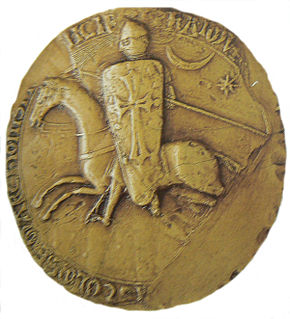
Raymond VI was Count of Toulouse and Marquis of Provence from 1194 to 1222. He was also Count of Melgueil from 1173 to 1190.
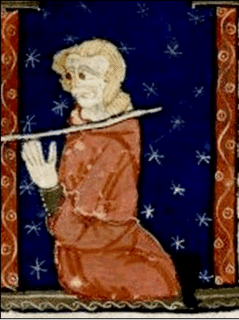
Raymond VII was Count of Toulouse, Duke of Narbonne and Marquis of Provence from 1222 until his death.
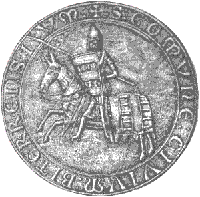
Raymond Roger Trencavel was a member of the noble Trencavel family. He was viscount of Béziers and Albi, and viscount of Carcassonne and the Razès.
The White Brotherhood was an urban society of Toulouse established in 1211 during the episcopate of Folquet de Marselha, so-called from its members' habit of wearing white crosses on their chests. The society, called a "pious institution" by William of Puylaurens, was militant towards usurers (Jews) and Cathars, robbing them and destroying their homes. Most of the Whites came from the city proper. A Black Brotherhood, so-called in opposition to the White, was soon formed and the two factions went to war in the streets of Toulouse. According to Puylaurens:
Daily the two parties would clash, banners flying, bristling with weapons, even with cavalry in evidence. Through the agency of His servant the bishop, Our Lord came to bring them, not a bad peace but a good war.
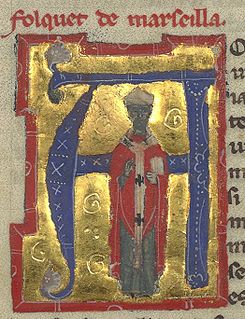
Folquet de Marselha, alternatively Folquet de Marseille, Foulques de Toulouse, Fulk of Toulouse came from a Genoese merchant family who lived in Marseille. He is known as a trobadour, and then as a fiercely anti-Cathar bishop of Toulouse.

The Song of the Albigensian Crusade is an Old Occitan epic poem narrating events of the Albigensian Crusade from March 1208 to June 1219. Modelled on the Old French chanson de geste, it was composed in two distinct parts: William of Tudela wrote the first towards 1213, and an anonymous continuator finished the account. However, recent studies have proposed the troubadour Gui de Cavalhon as the author of the second part. It is one of three major contemporary narratives of the Albigensian Crusade, the Historia Albigensis of Pierre des Vaux-de-Cernay and the Chronica of William of Puylaurens being the others.

Verfeil is a commune in the Haute-Garonne department in southwestern France.
Olivier de Termes was a knight from the southern French region of Termes, Aude. He was raised as a Cathar but eventually converted to Catholicism in a move that would help restore peace to his homeland following the ravages of the Albigensian Crusade.
Raymond de Fauga was a French Dominican, and bishop of Toulouse from 1232 to 1270. He was a significant figure in the struggle in Languedoc between the Catholic Church and the Cathars.
Constance of France was a French princess of the House of Capet, the only daughter of Louis VI of France and his second wife Adélaide de Maurienne. Amongst her siblings was Louis VII, who succeeded their father in 1137.
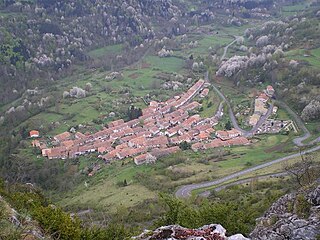
Montségur is a commune in the Ariège department in southwestern France.
Guilhabert de Castres was a prominent Cathar theologian. Born in Castres, he became a Cathar Perfect and, between 1223 and 1226, Bishop of Toulouse in the Cathar Church. In the theological debates in the early 13th century between the Cathars and the Papal representatives, he presented the Cathar arguments, including at the Debate at Montreal in 1206 and at the last Debate at Pamiers where he encountered Saint Dominic in 1207, prior to the Albigensian Crusades.

The Massacre at Béziers was the slaughter of the inhabitants during the sack of Béziers, an event that took place on 22 July 1209, and was the first major military action of the Albigensian Crusade.

The Siege of Montségur was a nine-month siege of the Cathar-held Château de Montségur by French royal forces starting in May 1243. After the castle surrendered, about 210 perfecti and unrepentant credentes were burned in a bonfire on 16 March 1244.
"Caedite eos. Novit enim Dominus qui sunt eius." is a phrase reportedly spoken by the commander of the Albigensian Crusade, prior to the massacre at Béziers on 22 July 1209. A direct translation of the Medieval Latin phrase is "Kill them. The Lord knows those that are his own". Papal legate and Cistercian abbot Arnaud Amalric was the military commander of the Crusade in its initial phase and leader of this first major military action of the Crusade, the assault on Béziers, and was reported by Caesarius of Heisterbach to have uttered the order.

The Siege of Minerve was a military engagement which took place in June and July 1210 during the Albigensian Crusade in the town of Minerve in southern France. It was undertaken by the Catholic Crusaders against the Cathars in southern France, who were regarded as a heretical sect. The Crusaders, led by French nobleman Simon de Montfort, besieged and captured the town. The Crusaders allowed the soldiers defending the town, Catholics, and any Cathars who had not yet reached the status of perfect to go free. Three Cathar perfects who repented were pardoned, but 140 others who refused to do so were burnt at the stake.
The Avignonet massacre occurred on the eve of 28 May 1242 when a small force, mainly consisting of Cathars, massacred a group of inquisitors during the Albigensian Crusade.